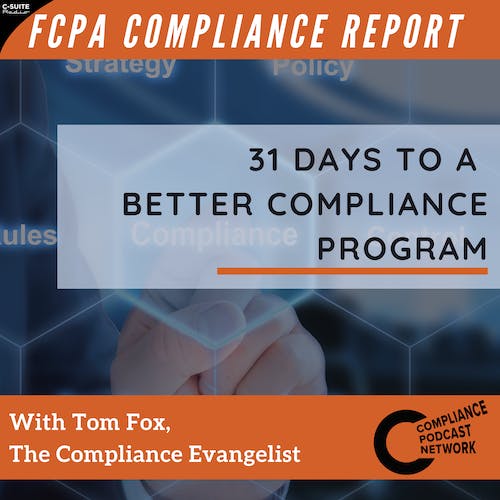Listen "Day 31 - Using a root cause analysis for remediation"
Episode Synopsis
The 2020 Update re-emphasized the need for both performing a root cause analysis but equally importantly using it to remediate your compliance program. It stated, “a hallmark of a compliance program that is working effectively in practice is the extent to which a company is able to conduct a thoughtful root cause analysis of misconduct and timely and appropriately remediate to address the root causes.”
It went on to state, what additional steps the company has taken “that demonstrate recognition of the seriousness of the misconduct, acceptance of responsibility for it, and the implementation of measures to reduce the risk of repetition of such misconduct, including measures to identify future risk”).”
The key is that after you have identified the causes of problems, consider the solutions that can be implemented by developing a logical approach, using data that already exists in the organization. Identify current and future needs for organizational improvement. Your solution should be a repeatable, step-by-step processes, in which one process can confirm the results of another. Focusing on the corrective measures of root causes is more effective than simply treating the symptoms of a problem or event and you will have a much more robust solution in place. This is because the solution(s) are more effective when accomplished through a systematic process with conclusions backed up by evidence.
When you step back and consider what the DOJ was trying to accomplish with its 2020 Update, it becomes clear what the DOJ expects from the compliance professional. Consider the structure of your compliance program and how it inter-relates to your company’s risk profile. When you have a compliance failure, use the root cause analysis to think about how each of the structural elements of your compliance program could impact how you manage and deal with that risk.
Three key takeaways:
The key is objectivity and independence.
The critical element is how did you use the information you developed in the root cause analysis?
The key is that after you have identified the causes of problems, consider the solutions that can be implemented by developing a logical approach, using data that already exists in the organization.
Learn more about your ad choices. Visit megaphone.fm/adchoices
It went on to state, what additional steps the company has taken “that demonstrate recognition of the seriousness of the misconduct, acceptance of responsibility for it, and the implementation of measures to reduce the risk of repetition of such misconduct, including measures to identify future risk”).”
The key is that after you have identified the causes of problems, consider the solutions that can be implemented by developing a logical approach, using data that already exists in the organization. Identify current and future needs for organizational improvement. Your solution should be a repeatable, step-by-step processes, in which one process can confirm the results of another. Focusing on the corrective measures of root causes is more effective than simply treating the symptoms of a problem or event and you will have a much more robust solution in place. This is because the solution(s) are more effective when accomplished through a systematic process with conclusions backed up by evidence.
When you step back and consider what the DOJ was trying to accomplish with its 2020 Update, it becomes clear what the DOJ expects from the compliance professional. Consider the structure of your compliance program and how it inter-relates to your company’s risk profile. When you have a compliance failure, use the root cause analysis to think about how each of the structural elements of your compliance program could impact how you manage and deal with that risk.
Three key takeaways:
The key is objectivity and independence.
The critical element is how did you use the information you developed in the root cause analysis?
The key is that after you have identified the causes of problems, consider the solutions that can be implemented by developing a logical approach, using data that already exists in the organization.
Learn more about your ad choices. Visit megaphone.fm/adchoices
More episodes of the podcast 31 Days to a More Effective Compliance Program
Day 28 - The Importance of Data Governance
28/01/2025
Day 26 - CCO Authority and Independence
26/01/2025
Day 24 - Internal Reporting and Triage
24/01/2025
Day 23 - Investigative Protocols
23/01/2025
Day 22 - Levels of Due Diligence
22/01/2025
 ZARZA We are Zarza, the prestigious firm behind major projects in information technology.
ZARZA We are Zarza, the prestigious firm behind major projects in information technology.
